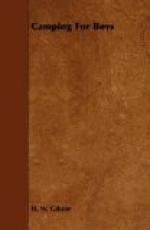Water Supply
Dr. Charles E. A. Winslow, the noted biologist, is authority for the following statement; [Camp Conference, p.61] “The source of danger in water is always human or animal pollution. Occasionally we find water which is bad to drink on account of minerals dissolved on its way through the ground or on account of passage through lead pipes, but the danger is never from ordinary decomposing vegetable matter. If you have to choose between a bright, clear stream which may be polluted at some point above, and a pond full of dead leaves and peaty matter, but which you can inspect all around and find free from contamination, choose the pond. Even in the woods it is not easy to find surface waters that are surely protected, and streams particularly are dangerous sources of water supply. We have now got rid of the idea that running water purifies itself. It is standing water which purifies itself, if anything, for in stagnation there is much more chance for the disease germs to die out. Better than either a pond or stream, unless you can carry out a rather careful exploration of their surroundings, is ground water from a well or spring; though that again is not necessarily safe. If the well is in good sandy soil with no cracks or fissures, even water that has been polluted may be well purified and made safe to drink. In a clayey or rocky region, on the other hand, contaminating material may travel for considerable distance under ground. Even if your well is protected below, a very important point to look after is the pollution from the surface. I believe more cases of typhoid fever from wells are due to surface pollution than to the character of the water itself. This is a danger which can, of course, be done away with by protection of the well from surface drainage, by seeing that the surface wash is not allowed to drain toward it and that it is protected by a tight covering from the entrance of its own waste water. If good water cannot be secured in any of these ways, the water must be purified. It has been said that what we desire in water supply is innocence and not repentance; but if you cannot get pristine innocence, you can, at least, secure works meet for repentance and make the water safe, by filtering through either a Pasteur or a Berkefeld filter—either of those filters will take out bacteria, while no other filters that I know of will or by various chemical disinfectants, not any of them very satisfactory—or, best of all, by boiling, which will surely destroy all disease germs.”
Indians had a way of purifying water from a pond or swamp by digging a hole about one foot across and down about six inches below the water level, a few feet from the pond. After it had filled with water, they bailed it out quickly, repeating the bailing process about three times. After the third bailing the hole would fill with filtered water. Try it.
Drinking Cups
Insist upon the boys bringing to camp a supply of inexpensive paper cups or collapsible pocket drinking cups. Filthy and dangerous diseases are not infrequently transmitted by the use of a common drinking cup.




